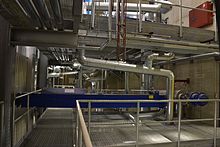Sootblower


Sootblowers are used to clean the flue gas side of heating surface pipes in fossil and biomass- fired steam boilers using steam.
The combustion process creates deposits on these pipes (especially fly ash and soot, these vary greatly depending on the fuel used ), they have a negative impact on the heat transfer in the steam boiler and thus reduce the efficiency of the system.
In many designs, sootblowers are designed as tubes, which have a certain number of outlet holes and are guided along the heating surfaces. Steam is fed into this tube and exits through the holes directed towards the heating surfaces. This removes fly ash and soot from them.
Steam is used for two reasons: On the one hand, in order to prevent thermal tension, the cleaning measure should not noticeably cool the heating surfaces (which would be the case with water). On the other hand, no substances may be used that would have a lasting effect on combustion (e.g. air).
There are different designs of sootblowers:
- Wall blower: These are used to clean dirt from the wall heating surfaces.
- Screw blowers: These clean the bundle heating surfaces in the event of heavy contamination, whereby the blower pipe remains in the flue gas flue .
- Lance screw blowers: These clean the bundle heating surfaces in the event of heavy soiling and high flue gas temperatures, while the lance tube with two opposing high-performance nozzles is driven into the boiler with steam at the start of blowing. It is primarily used to clean superheaters .
- Rotary pipe blowers: These clean the bundle heating surfaces in the event of slight contamination, whereby the blow pipe remains in the flue gas and performs pure rotary movements.
- Pendulum blowers: These clean the bundle heating surfaces in the event of heavy soiling and high flue gas temperatures.
- Traverse blowers : These clean the bundle heating surfaces in DeNOx systems and air preheaters , whereby the blower element remains in the flue gas and performs a pure forward movement.
- Axial blowers: These clean the bundle heating surfaces in the event of heavy contamination by means of a pure feed movement.
- Two-substance blowers: These clean gas and air preheaters with steam or air and water, whereby the blowing element remains in the preheater and performs a pure forward movement.
Individual evidence
- ↑ Sootblower ( page no longer available , search in web archives ) Info: The link was automatically marked as defective. Please check the link according to the instructions and then remove this notice. Retrieved on 1.X.2011.
- ↑ a b Andreas Oberhammer et al: Biomassefernwärme für Steyr, Fernwärmetage 2013, Fachverband Gas Wärme ( Memento of the original from May 25, 2014 in the Internet Archive ) Info: The archive link was inserted automatically and has not yet been checked. Please check the original and archive link according to the instructions and then remove this notice. .